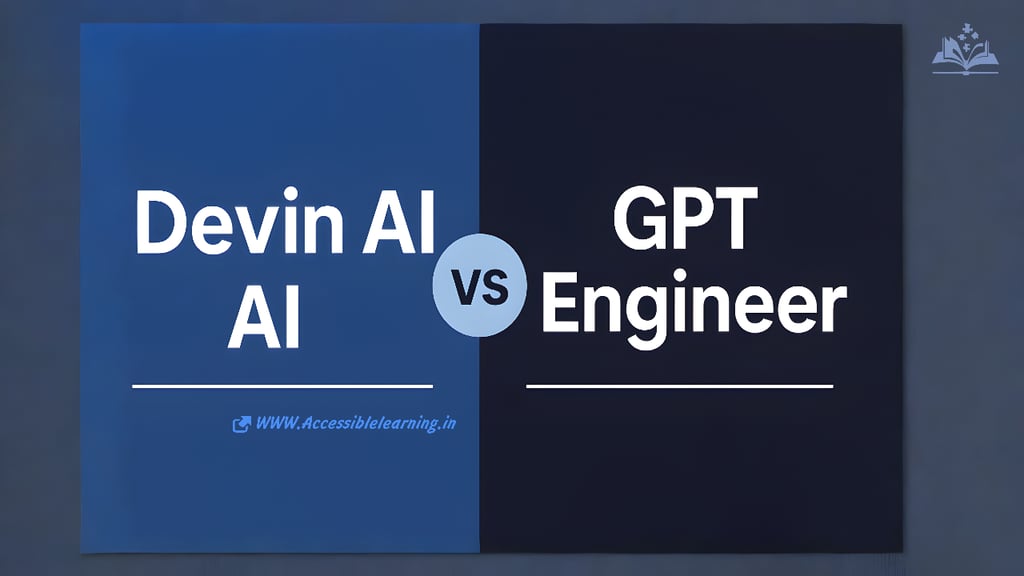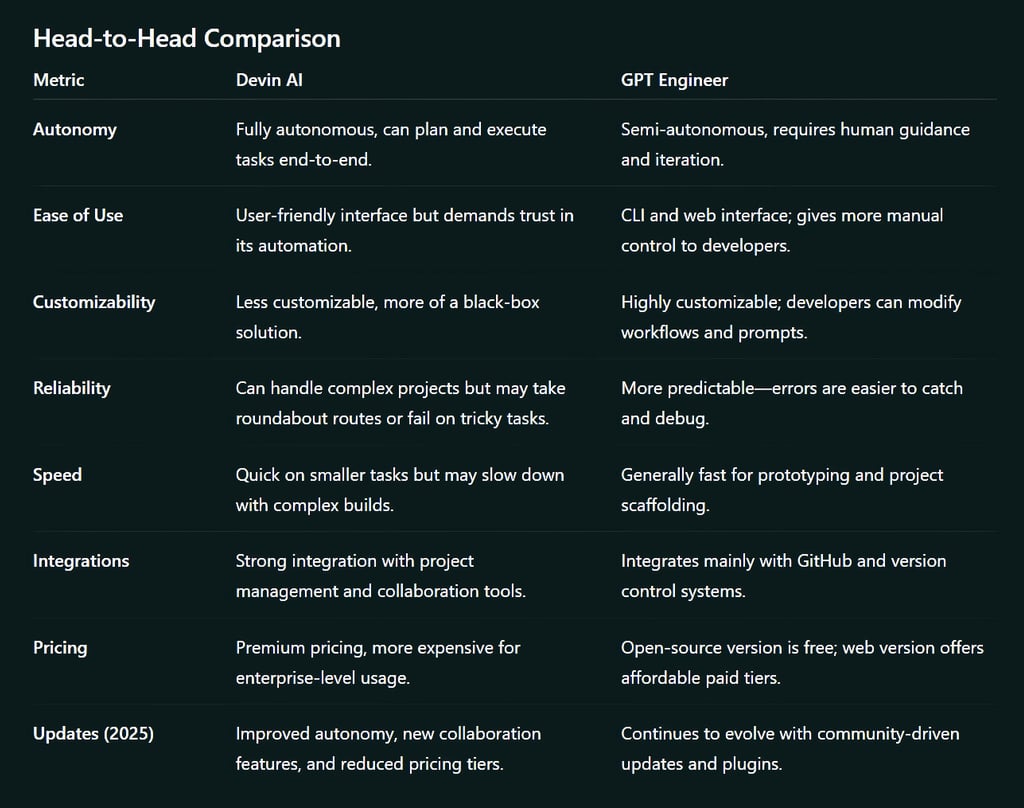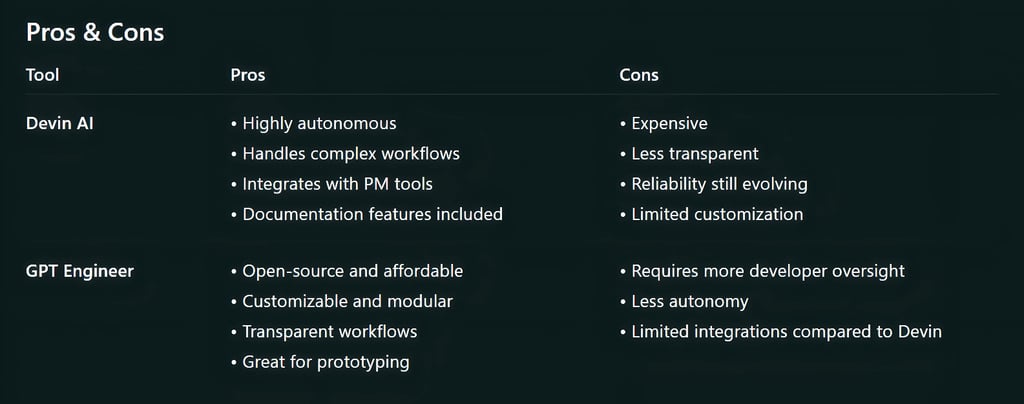
Devin AI vs GPT Engineer: A Complete 2025 Comparison
Explore the ultimate 2025 comparison of Devin AI vs GPT Engineer. Discover their AI tool features, performance, pricing, pros & cons, best use cases, and which is the best AI alternative for developers and teams.
AI ASSISTANTAI/FUTURECOMPANY/INDUSTRYEDITOR/TOOLS
Sachin K Chaurasiya
10/12/20255 min read


The world of software development is transforming rapidly, with AI coding assistants becoming more powerful. Among the many players, Devin AI and GPT Engineer stand out as tools that promise to convert natural language into functional code.
But here’s the catch: while both tools share the same vision, they differ in features, autonomy, usability, and cost. Choosing the right one can save developers hours of effort, reduce costs, and ensure reliable project outcomes. That’s why this comparison matters in 2025.
Devin AI
Devin AI is marketed as the world’s first autonomous AI software engineer. It doesn’t just generate code—it can plan tasks, execute them step by step, test outcomes, fix issues, and deliver a complete solution. The tool behaves like an independent agent, capable of handling software development tasks with minimal human input.
Key Features
Autonomous project planning and execution.
Ability to write, test, debug, and refine code.
Handles refactoring, migrations, and technical debt cleanup.
Integrates with project management tools like Jira, Linear, and Slack.
Offers auto-documentation and knowledge search through a built-in Wiki system.
Capable of asking clarifying questions when uncertain.
Devin is designed for teams who want to offload repetitive coding tasks or manage large backlogs with minimal developer supervision.
GPT Engineer
GPT Engineer, on the other hand, started as an open-source tool that generates complete codebases from natural language specifications. It allows developers to describe what they want in plain English, and the system scaffolds an entire project—files, structure, dependencies, and even tests.
Key Features
Converts plain text prompts into full codebases.
Offers interactive refinement by asking clarifying questions.
Supports iterative improvement—run it again for bug fixes or enhancements.
Highly customizable with modular prompts and internal workflows.
Open-source foundation, allowing developers to tweak and extend it.
Integrates with GitHub and version control for easy collaboration.
Unlike Devin, GPT Engineer is not fully autonomous—it keeps the human developer in the loop. This makes it ideal for prototyping and experimentation while retaining developer oversight.




Use Cases & Best Fit
For Startups and Prototyping:
GPT Engineer is better suited since it allows quick iteration and hands-on debugging.For Established Teams with Backlogs:
Devin AI shines by handling repetitive coding, migrations, and maintenance tasks autonomously.For Researchers and Tinkerers:
GPT Engineer is ideal because of its open-source flexibility and customizable workflows.For Non-Technical Managers:
Devin AI offers a hands-off experience where a feature request can turn into delivered code with minimal oversight.For Mixed Development Teams:
A hybrid approach works best—use GPT Engineer for critical logic and Devin AI for supporting tasks.
Philosophical Difference in Design
Devin AI is built around the autonomous agent philosophy. It acts like a “virtual engineer” who takes instructions, makes decisions, and executes them. The goal is to minimize human involvement.
GPT Engineer follows the human-in-the-loop philosophy. It doesn’t try to replace developers but augments their workflow, giving them scaffolding and draft solutions that they can refine.
This distinction is important for teams deciding whether they want to delegate work entirely or retain close control.
Learning Curve & Trust Factor
With Devin AI, the challenge isn’t just learning the tool but learning to trust it. Since it can execute multi-step tasks on its own, teams need to monitor its results until they’re confident in its consistency.
With GPT Engineer, the learning curve is technical (especially in the CLI version), but once learned, it provides predictable and transparent results.
Collaboration Styles
Devin AI is designed to fit into enterprise workflows. Its integration with Jira, Slack, and Linear makes it attractive to larger companies managing distributed teams.
GPT Engineer, while growing, still thrives in developer communities and open-source ecosystems. It’s more about experimentation, customization, and peer-driven improvement.
Performance Beyond Code Writing
Devin is not just about generating code. It can migrate databases, update frameworks, and perform testing cycles automatically. This makes it closer to an AI DevOps partner.
GPT Engineer is mainly focused on building from scratch or adding new features. It excels at bootstrapping new projects or providing a strong base that developers can extend.
Adoption & Market Reception
Devin AI has generated excitement but also skepticism. Some developers find its autonomy impressive, while others report it “overcomplicates simple tasks.” The market sees it as a premium innovation tool, still maturing in real-world reliability.
GPT Engineer enjoys steady adoption because of its open-source transparency and low entry barrier. Startups and indie developers particularly love it as the best AI alternative to costly enterprise tools.
Future Trends to Watch (2025 and beyond)
Devin AI is likely to evolve into a team-based AI engineer, collaborating with multiple agents in parallel (think “AI development pods”).
GPT Engineer may expand into a plugin ecosystem, where developers share templates, workflows, and specialized modules—turning it into a community-driven coding powerhouse.
The broader trend is towards hybrid coding: human developers orchestrating multiple AI assistants, each with different strengths.
Hidden Strengths & Weaknesses
Devin AI Hidden Strength: Its ability to continuously learn within a session—spotting patterns in the codebase and adjusting plans accordingly.
Devin AI Weakness: Lack of transparency makes it harder for teams to understand why it chose a particular approach.
GPT Engineer Hidden Strength: Because it’s modular, it can be integrated with other AI models (not just GPT), giving developers freedom to choose their LLM backend.
GPT Engineer Weakness: Without autonomy, it can’t manage long development tasks end-to-end; humans must step in frequently.

Industry Fit
Devin AI suits industries where automation and speed outweigh perfect precision—such as startups testing product-market fit or enterprises handling repetitive backlog tasks.
GPT Engineer suits industries needing safety, compliance, and customization, like healthcare, finance, and research, where code must be reviewed and audited carefully.
FAQs
Q: Can Devin AI replace human developers?
Not yet. It’s effective for automating repetitive or structured tasks but still requires oversight for complex projects.
Q: Is GPT Engineer free?
Yes, the open-source version is free, but there are paid tiers for the hosted web version.
Q: Which tool is more reliable for production code?
Currently, GPT Engineer offers more predictable results since developers can oversee and refine outputs. Devin is powerful but still prone to unexpected errors.
Q: Which one is best for beginners?
GPT Engineer is easier for beginners since it provides transparency and allows step-by-step debugging. Devin requires more trust in the AI’s autonomy.
Both Devin AI and GPT Engineer represent the future of AI-assisted software development, but they target different needs:
Choose Devin AI if you want a hands-off AI assistant that can autonomously handle software engineering tasks and you’re ready to pay a premium for it.
Choose GPT Engineer if you value control, transparency, and flexibility—especially for prototyping, experimentation, or when working on a budget.
In 2025, the smartest strategy for most teams is to combine both tools: rely on GPT Engineer for critical, human-in-the-loop development and use Devin AI for routine tasks and backlog automation.
Subscribe to our newsletter
All © Copyright reserved by Accessible-Learning
| Terms & Conditions
Knowledge is power. Learn with Us. 📚


